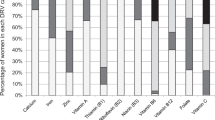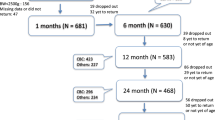Abstract
Objective: To gain information about the micronutrient status of urban, middle-income, breast-feeding mothers in relation to zinc and selected fat-soluble vitamins in plasma and breast milk and to assess possible interaction between the measured micronutrients.
Design: Cross-sectional study
Subjects: 91 mothers and their infants living in middle-income areas of Jakarta, Indonesia
Results: None of the measured anthropometric data of the mothers (e.g. BMI: 22.0±3.1 kg/m2) and their infants (birth weight: 3.2±0.5 kg) gave any indication of undernutrition. The mean concentrations in blood were 124±18 g/l for hemoglobin, 385±111 μg/l for retinol, 34±23 μg/l for α-carotene, 104±72 μg/l for β-carotene, 7.7±3.3 mg/l for α-tocopherol, 0.57±0.23 mg/l for γ-tocopherol, 855±242 μg/l for zinc, and the median concentration of lycopene was 29 μg/l. The median breast milk concentrations were 420 μg/l for retinol, 7.8 μg/l for β-carotene, and 2.7 mg/l for zinc. With increased duration of lactation, vitamin A and zinc concentrations significantly decreased in breast milk whereas plasma zinc concentration increased. Plasma α- and β-carotene were positively correlated (P<0.0001) with each other and with plasma lycopene. Breast milk β-carotene was positively correlated with breast milk retinol and with plasma β-carotene (P<0.0001). There was no correlation between zinc and vitamin A in either breast milk or plasma. Forty per cent of the mothers were anemic, 29.1% had a low plasma zinc concentration, and 23.7% had a moderately low plasma vitamin A concentration. Breast milk from 70% of the women had a low concentration of vitamin A and that from 66% had a low concentration of zinc.
Conclusions: Multi-micronutrient intervention should be considered to provide a sufficient supply of zinc and vitamin A for growth of exclusively breast-fed infants.
This is a preview of subscription content, access via your institution
Access options
Subscribe to this journal
Receive 12 print issues and online access
$259.00 per year
only $21.58 per issue
Buy this article
- Purchase on Springer Link
- Instant access to full article PDF
Prices may be subject to local taxes which are calculated during checkout
Similar content being viewed by others
Author information
Authors and Affiliations
Rights and permissions
About this article
Cite this article
Gross, R., Hänsel, H., Schultink, W. et al. Moderate zinc and vitamin A deficiency in breast milk of mothers from East-Jakarta. Eur J Clin Nutr 52, 884–890 (1998). https://doi.org/10.1038/sj.ejcn.1600660
Received:
Revised:
Accepted:
Published:
Issue Date:
DOI: https://doi.org/10.1038/sj.ejcn.1600660



